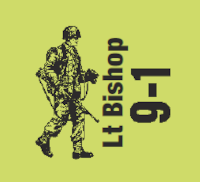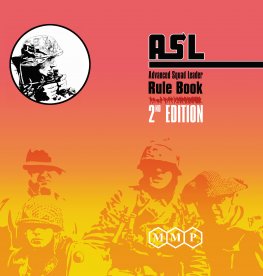
Today, I have a short article stemming from my experience playing ASL with the Friday Night Aberdeen ASL group. They are a bunch of great guys and it gives me the opportunity to interact and play ASL with a whole new group of UK-based players. It is a fantastic time. But I digress. In one of the Friday night games, I was taught (or perhaps re-taught, I cannot remember) a new rule. Let me share it with you.
The Situation
Joe Arthur and I were playing BFP 107 Costly Baptism. In the game, I attempted a Bounding First Fire shot with an AAMG Main Armament with one of the armored “jeeps.” I dutifully counted up my DRM and said the shot was +2 Case B, +3 Case C and announced a +5 DRM shot. Joe quizzically said, “I think you’re wrong, Jim. It’s only +2.” Me being me, I was thinking Joe was wrong, and I was right. I looked at my official MMP charts and shared the image below with Joe.

Joe countered by sharing this image from his LFT Rat Charts.

Which one is correct? Actually, they are both correct however, the official chart is correct through omission.
The Actual Rule
Turns out, even the actual rule is hard to find. It’s buried in the example and not explicitly called out in the rule text.

C5.3 CASE C; BOUNDING FIRER: A vehicle (including its Passengers) which has entered a new hex/hexside during its MPh but does not fire until its AFPh is using Bounding Fire and always uses Case C when firing ordnance.
Vehicular (including Passenger) ordnance which fires during its MPh (D3.3) must use one of the Case C DRM (i.e., it must add the +2 DRM of Case B to the applicable Gun Type DRM of Case C) as Bounding First Fire for any shot it takes. A vehicle with a Multiple ROF may not fire again until it has expended another MP (even if only a Delay MP).
EX: A Stabilized Gun (D11.11) firing in the AFPh after entering a new hex during that Player Turn must apply a +3 DRM (case B + C; 2 + 1) to its To Hit DR; a T or ST Gun Type must add a +4 DRM (2 + 2); a NT Gun Type or any Passenger must add a +5 DRM (2 + 3). MA AAMG would add +2 DRM (Case B only).
I have made the relevant text bold to make it easier to see because I had missed it for decades. This makes a B1F shot by a halftrack much more likely to hit than I had previously thought. I thanked Joe for showing me this and I am sharing it here now so others can learn from my mistakes (including the comeuppance associated with hubris). Thanks for being patient with me, Joe.
Conclusion

I don’t care who you are or how long you have played the game, there is still more to learn. I have said many times there are two separate games being played at the same time: you against your opponent and both of you against the game. Here, Joe carried me in the second battle.
Additionally, this also conveys a point I have made several times before: if you can, play widely. The more diverse your base of opponents is, the more likely it is you will find someone who catches one of these edge rules. Until next time. – jim


Very interesting point. I don’t think I have ever seen that one before either. Good one.
Jim, I’m glad I stumbled upon your blog. I’ve been playing ASL/SL since the Purple Box days but I’ve gone through several periods of zero play, the latest of which lasted 5 years after which I am just now getting back into the game. Your posts are providing a good source of material for rules diving as I return to the game, much more so than just re-reading the rules page by page.
As far as this post, I re-read D1.83 ANTI-AIRCRAFT MG (AAMG): The AAMG FP may be used either within or outside of its vehicular current TCA/VCA at no penalty; i.e., for rules purposes it is considered neither “turret-mounted” nor “bow-mounted”. That last part about the AAMG being neither turret-mounted or bow-mounted makes perfect sense when you use it as a lens to read C5.3 through (assuming one notices the last sentence of the EX…), but I never would have made that connection on my own and most likely would have also come up with a +5 DRM. Since C5.3 never actually mentions that AAMGs are not subject to the extra weapon mount DRM of Case C is yet another rule in a long line of rules that like you say is “correct by omission” but nonetheless leads to a lot of players (including myself) not seeing it.
That does point out some consistency in the rules. Of course, it just adds to the obscurity by mentioning “[EXC: AAMG with restricted CA (e.g., German StuG IIIG or French H35) must pay the applicable Case A penalty for changing TCA/VCA as appropriate].” This again requires players to infer the AAMG DOESN’T pay Case A. All these pages and no where is it plainly stated except buried in the Example. — jim
New to me, but also makes total sense in light of the AAMG’s 360 CA!
Thanks for this, Jim.
Jim,
As I read C5.3, the example is not making a rule but reflecting the rule. The second paragraph of C5.3 makes clear that MG’s firing as B1F (by virtue of NOT being ordnance) do not add case C. The example is just reflecting that a vehicular MG is not ordnance despite it could OPTIONALLY fire using the ToHit/TK process.
Relevant references below (emphasis mine):
Index: Ordnance (any weapon which MUST score a hit on a To Hit Table before rolling again on the IFT or To Kill Table to resolve that hit)…
C5.3: Vehicular (including Passenger) ORDNANCE which fires during its MPh (D3.3) must use one of the Case C DRM (i.e., it must add the +2 DRM of Case B to the applicable Gun Type DRM of Case C) as Bounding First Fire for any shot it takes.
Perhaps it wasn’t clear, but this article is referring to firing as Ordnance. The reference to Bounding First Fire is perhaps not as clear as it should be. So if you have a turreted MA that is a MG, you would pay +4 TH (Case B + Case), ignoring all other possible DRM. If instead, you were using a half track–many of which have an MG for a MA–you would only pay +2 since Case B is +0 for an AAMG.